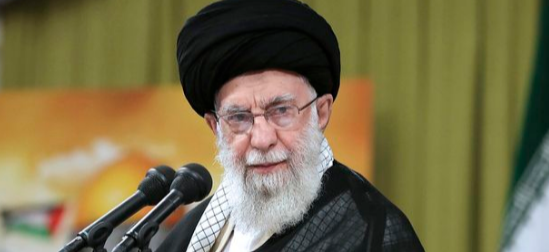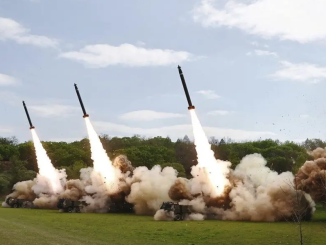
The U.S. and Iran edged closer to a full-blown military confrontation Thursday after a series of clashes between American troops and Iranian proxy forces, as the Israel–Hamas war threatens to drag the entire Middle East into a new cycle of conflict.
Defense Secretary Lloyd Austin tried to tamp down the prospect of escalation. He said Pentagon leaders “are going to do everything in our power” to ensure that a wider war doesn’t erupt across an increasingly tense, dangerous theater.
A top Hamas leader boasted this week that a state of “perpetual” war with Israel and chaos across the region are the militant group’s overriding aims. He suggested that the rapidly rising tensions represent the exact outcome Hamas was hoping to achieve with its Oct. 7 terrorist assault on Israel.
{snip}
Meanwhile, Iran-backed Houthi rebels shot down a U.S. drone Wednesday off the coast of Yemen. It was the second direct clash between U.S. troops and Iranian proxies on the same day in different corners of the Middle East. Hezbollah militia forces in southern Lebanon continue to engage in a simmering series of border exchanges with Israeli troops that have killed dozens.
Despite U.S. warnings, Houthi forces on Thursday claimed to have launched a “barrage of ballistic missiles” targeting the Israeli Red Sea city of Eilat. Israel’s military reported that a drone hit a school but caused no physical injuries. Another missile of unknown origin was intercepted and blocked over the Red Sea.
President Biden has ordered two strikes on Iran-backed militias, but some analysts say the White House hasn’t responded forcefully enough and is paving the way for inevitable American casualties.
“Iran has concluded that they can get away with murder,” said Michael Rubin, a former Defense Department official and now a senior fellow at the American Enterprise Institute. “They do not believe Biden has the wherewithal to do anything significant, whatever the provocation. So, expect Americans to come home in body bags.
“Indeed, [Iran’s supreme leader, Ayatollah Ali Khamenei] believes that he can force the U.S. to ‘pull an Afghanistan’ and withdraw completely from the region,” Mr. Rubin told The Washington Times. “Weakness is provocative, and so the U.S. should expect further escalation from Iran and its proxies.”
The Israel-Hamas battle in Gaza shows no signs of stopping in the coming weeks and months.
{snip}
Iran is the primary financial backer of Gaza-based Hamas and Lebanon-based Hezbollah. Hezbollah also has threatened escalation against Israel, though its leaders have signaled a reluctance to start a full-fledged war.
The unfolding chaos in the Middle East seems to be by design. Plunging the entire region into battle and trapping Israel — and, by extension, its key allies such as the U.S. — in an endless war was a central goal of Hamas’ attack, one of the group’s leaders said. The Palestinian cause, which seemed to be relegated to the back burner just over a month ago, is now on the front pages of newspapers worldwide.
“Now no one in the region is experiencing calm,” Khalil al-Hayya, a member of Hamas’ top leadership body, told The New York Times in an interview published Thursday. “I hope that the state of war with Israel will become permanent on all the borders and that the Arab world will stand with us.”
Strike Iran?
The Pentagon has dispatched military assets, including two aircraft carrier strike groups and a nuclear-powered submarine, to the Middle East in recent weeks as a show of support for Israel and as a deterrent against Iran and its proxies. The string of attacks by Iran-linked militias has wounded at least 21 U.S. service members and led to the death of one American contractor who suffered a cardiac incident while sheltering in place.
{snip}
Mr. Austin told reporters Thursday that the U.S. is prepared to increase its response if the wave of assaults continues.
“If the attacks against our forces don’t decrease or stop, we will take additional measures,” he told reporters while traveling to India. “We’re going to do everything we can to protect our troops, and we are absolutely serious about that.”
Mr. Austin offered little clarity on the drone incident Wednesday. U.S. officials confirmed that Iran-supported Houthi forces shot down an Air Force MQ-9 Reaper drone operating in international airspace off the coast of Yemen. The Houthi rebels have aligned with Hamas against Israel. Its missile and drone attacks have been thwarted so far.
The Pentagon did not name the militias targeted in Wednesday’s strikes in Syria, but the groups Kata’ib Hezbollah and Kata’ib Sayyid al-Shuhada have been responsible for many of the attacks against American forces in the region over the past few years.
National security and foreign policy circles have legitimate questions about how much operational control the regime in Tehran wields over those groups. It is not clear whether Tehran is directly involved in the planning or execution of attacks on U.S. personnel or whether it is aware of those attacks beforehand. Some analysts argue that the groups have grown more autonomous over recent years.
For a growing number of U.S. officials, that doesn’t matter. Striking Iran directly is now an open discussion in Washington, and it was a rare source of unity at the Republican primary candidates’ debate in Florida on Wednesday night.
“I would tell President Biden with great clarity, if you want to stop the 40-plus attacks on military personnel in the Middle East, you have to strike in Iran,” said Sen. Tim Scott of South Carolina, a Republican presidential hopeful.
{snip}
Sen. Lindsey Graham, South Carolina Republican, and Sen. Richard Blumenthal, Connecticut Democrat, said recently that they would introduce a nonbinding resolution calling on the U.S. to strike Iran directly if Hezbollah opens a second front in the war against Israel.
Under fire in Syria
The constant threat to U.S. troops has added fuel to the long-simmering debate about the strategic value of keeping American forces in critical parts of the region, particularly Syria. The U.S. has about 900 troops stationed in Syria, with the ostensible goal of working with Kurdish allies to wage war against the Islamic State terrorist network.
Those American troops routinely carry out anti-ISIS missions and have notched several high-profile successes in recent months. The Pentagon has made clear that it will not adjust that counter-ISIS mission even in light of attacks against U.S. personnel on the chaotic Syrian battlefield.
“We urge against any escalation. U.S. personnel will continue to conduct counter-ISIS missions in Iraq and Syria,” Mr. Austin said in a statement Wednesday after the most recent round of strikes on Iran-backed militias in eastern Syria.
Some analysts say the growing dangers underscore the foolishness of keeping U.S. troops in harm’s way.
{snip}
“The U.S. military presence is not only unnecessary but also a dangerous tripwire for a wider war,” said Daniel DePetris, a fellow with the think tank Defense Priorities, which advocates for a more limited U.S. military role abroad.
“A perpetual U.S. deployment remains high cost with no justifying security benefit,” he said. “It is negligent to keep U.S. forces in Syria and even Iraq where they remain targets from groups that otherwise couldn’t reach Americans. They should immediately redeploy to better-defended bases and eventually outside the region.”
* Original Article:
https://www.washingtontimes.com/news/2023/nov/9/expect-americans-body-bags-middle-east-brink-us-ir/?utm_source=smartnews.com&utm_medium=smartnews&utm_campaign=smartnews%20


